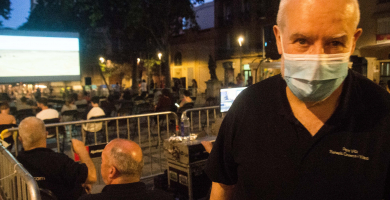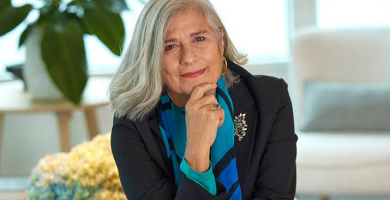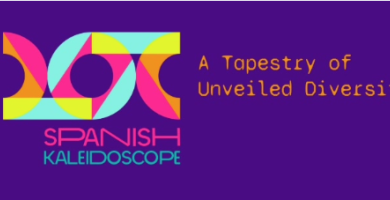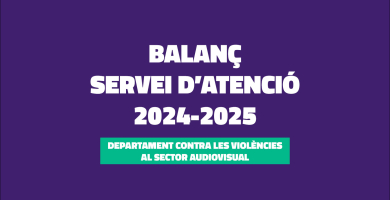
PERE VILA: “Now you’re a computer specialist rather than an operator. The magic of cinema has been completely lost. Now you don’t have the projectionist always in the box, looking to see whether the film’s in focus, if it breaks, if anything happens.”
This month we interview Pere Vila, a cinema projectionist who talks to us about his work, which is endangered, and about the changes the sector has undergone with the arrival of digital technologies. Vila was born in 1951 in Molins de Rei and has always worked in cinema projection. He moreover has an audiovisual company called Pere Vila Audiovisuals S.L. which offers all kinds of services related to audiovisual projections.

The profession of the projectionist is almost completely unknown by the people who enjoy going to the cinema. What does your work consist of?
It’s nothing like the profession that we knew during the years of cinema with a physical film now that we’re in the digital age. There’s a huge difference. Nowadays the projectionist doesn’t even go to the projection box. The entire job is carried out from an office, using computer technology, with the films uploaded onto the server and the projector. The only thing you have to do, from time to time, is to check the projector. Before, the projectionist was the person in charge of the film when it arrived; they checked it, assembled the different reels and then reviewed the format, the condition of the copy, the perforation... Then they carried out a test and it was projected. Nowadays, it’s a hard disc which you upload on the server and the whole job afterwards is by computer.
The trade has changed a lot over these years. How did you experience the change from 35 mm to digital? From your experience what were the challenges?
I came from an analogue world in which everything could be touched: the film, the machine,... And now it’s all by computer and you have to keep up to date with the computer technology, know all the projection systems that exist, the formats, programs, etc. Before, being physical, you could touch and fix it. A belt broke or you had to change a lamp and you did it quickly and the session continued. Now, if it breaks, you can’t continue with the projection. If any part of the projector fails then you have to suspend the session; you can’t mend it. First, because you don’t know what part of the projector has broken. Second, it’s very difficult to have spare parts for each part of the projector which might break, because they’re very expensive.
Now you’re a computer specialist rather than an operator. The magic of cinema has been completely lost. Now you don’t have the projectionist always in the box, looking to see whether the film’s in focus, if it breaks, if anything happens. The operator was always keeping an eye out. Now, it’s a very mechanical job and it’s very easy for you to be stuck with any problem you encounter, for example if the film stops or you lose the sound.
Does 35 mm film still exist?
Very little. We show one film a year in the Gavà film club. And, very sporadically, someone asks us for a classic film. Maybe over these 10 years of change from 35 mm to digital, we’ve only shown seven or eight films in 35 mm.
Projecting a film requires a lot of detail and you have to pay a lot of attention; it’s very precise and meticulous. What qualities did a good projectionist need?
First, they needed to like the work, because it’s not a mechanical job; you have to take care with what you’re doing. For example, treating the film well or, when it comes to loading it on the projector, it must always be clean... or to have the correct lenses when it comes to screening the film, because it’s not like with digital when with the same lens you change the format and it’s all done with the computer. With 35 mm you have to have the right lenses for each film and even more so if you do screenings like we did in the open air. Each session was a different cinema with different focal lengths and optics. You usually do all the work by yourself with your hands so that people can enjoy the film.
Your vocation as a projectionist began when you were very young. How did it arise?
My grandad took me to the cinema when I was six years old. He had a friend who was a projection box operator and we went to see him. They were screening the film Pinocchio. I remember that there was a point when the film was burnt and he very quickly broke the piece that was burnt, a few metres of film which fell to the floor. I was really impressed. And whenever I went to the cinema with my grandad I told him I wanted to go to the projection box to see it. When I was eight, my parents asked me what I wanted for Christmas and I asked for a machine to show films. Because I’ve always liked that magic that means you can see images through a device. And this meant that, when I was 14, I began to go to the cinema in a parish centre in Molins de Rei. In 1966 they bought a projector and I was one of the first to operate it in 35 mm. I remember perfectly well that it was That Darn Cat! by Disney with the actor Dean Jones. That was the first film with which I learnt to project films and from then on I worked as an operator.
What was that first experience like?
Quite difficult and very scary (laughs), because it was a film that was screened with a carbon machine. There still weren’t xenon lamps like in the later years. Normally, a film lasted one and a half hours, but the carbons didn’t last for the whole film. After one hour you had to change the carbon, and you had to be highly skilled not to stop the machine and, of course, we didn’t know how to do it. We passed the reels, the three parts that there were on a reel, and when they ended we had an interval, we stopped and we began again with the following one after changing the carbon. Later on, we saw that this was a problem, because you had to be a very good professional and very skilful to change the carbon while it was in operation. After one year, we asked for a machine with a xenon lamp so we wouldn’t have to use carbons.
Also, the machines weren’t prepared to change the reel without stopping the projection, as they were later when the films were assembled on a 4,000 metre reel and you could screen it continuously. So as not to stop the projection, every two parts of the film we threw the last 20 or 30 metres which were left onto the floor, we spliced the end of one reel to the next one, we put the film back on and when it went through the machine again we took it out below. Before the machines weren’t designed to pass a whole film in one go, but rather to have two machines and each machine with one reel. As this was very expensive at the time, not all cinemas had two and they had to devise a way to be able to screen the whole film with one machine.
Was that your training as a projectionist?
I was taught by a man who was 10 or 12 years older than me. He’s still alive. It was Mr Marín from Molins de Rei. He introduced me to the profession. He taught me how to assemble the films, the formats, the optics... he was like a father to me, as it were, in the profession.
When and why did you create your company Pere Vila Audiovisuals S.L.?
Before this, my dream had always been to make films. One day, one of the doormen at the cinema told me a heartbreak story and I wanted to portray it in a film. And between 1972 and 1974 I made many amateur cinema and super8 films. This meant that I not only saw the projectionist side of the cinema but also the creative side. Then, I studied in the film school for three years and I began to make my first films in 16 and 35 mm. I made one feature length film and I was five years in the profession.
I left professional films in 1986. At that time cinemas were going through quite a serious screening crisis. I’ve always thought that if you’re going to devote yourself to something you must know the profession. And I’d known the projectionist profession since the age of 14. So we created the audiovisual services company which was first with 35 mm and we offered a service in the summer with open-air screenings and in the winter to many film clubs for which we did the projections. This has continued until now.
What services do you offer?
We’ve adapted to the circumstances and the time. Before it was all in 35 mm. We managed the rights for the film, we took it, we projected it and even, in some film clubs, we looked for people to make up the audience for the film. This was one more service that you could offer the client. Over time, the service we provide has changed with the projection systems. At the beginning with DVD, then with Blu-ray and now with digital. Over the year we dedicate a lot of time to managing rights. With 35 mm films it was just you and a few more people because they didn’t have those mobile machines for screening. Nowadays, all cultural centres or theatres have bought their own projector and their screen and they do it all themselves. The travelling projectionist profession is disappearing. Now it’s just based on film festivals and open-air films in the summer, because many people don’t have mobile projectors. The rest of the year we specialize in managing rights. For example, a council wants to screen a film, we manage the rights, we provide it with the digital archive and for this work we charge a commission. Apart from holding the occasional film club session in digital format, now it’s all DCP. We have three devices to provide this service. It’s the same as 35 mm was before. Not everyone can offer films in DCP or 35 mm, but with digital, with a file which isn’t encrypted or in Blu-ray, anyone can. But we are only a few companies in Catalonia offering DCP.
Is DCP more advantageous or does it have more problems than for example 35 mm or digital? What is the difference?
It’s advantageous in so far as the copies do not deteriorate. You have to accept that. Before you made a film and after six or seven months you found it scratched, or the sound had disappeared... There was a series of disadvantages that you don’t have with DCP. As for the quality of the projection, the DCP that we now call 2K, and which is 90% of films and the prevailing system, doesn’t have the same sound or image quality as 35 mm. 35 mm would be equal to around 5K or 6K image resolution quality and the resolution of DCP is very similar to Blu-ray.
The other advantage it has is that before a copy in 35 mm cost €3,000 or €4,000 and now a DCP costs €20. When you finished with a copy in 35 mm you had to burn it and this had a cost. And apart from the fact that it was extremely expensive, to cover the cost of a copy you had a series of very big associated costs. Nowadays, after three months the distributor deletes it and puts another. This is a very practical and economical system for the distributors. But if we look back at what it meant before to see quality films, with good Dolby digital sound, nowadays all that has been lost because films have increasingly become a throwaway product, like television. With the great majority of films, what you saw today you don’t even remember in three months’ time unless it was a very important film.
The whole system has gradually adapted to this way of doing television. The broadcasting system has won against what is the great cinema experience. And traditional cinema has less and less of a future. This has become increasingly evident with the pandemic and platforms: each person consuming what they want when they want. On the contrary, with cinema if you wanted to see a film you had to go on that day, at that time, in that place. Cinemas will end up with big shows and there will be few in Barcelona. This cinema will show it for two or three weeks and then they’ll put it on the networks as some multinationals are already doing now. And all the small cinemas will gradually disappear, because nowadays they aren’t profitable because of the cost represented by maintaining these machines. A DCP device costs €40,000 or €50,000. No one guarantees that you’ll have it for your whole life. The card or the server breaks and that costs a lot of money. And if you add it all up, how long you need to cover the cost, it’s not worth it. It would ruin a small entrepreneur. Not a big one, because they premiere the film and if it’s good they make a lot of money in those two or three weeks, because they work on a percentage basis with the distributors, but for the small ones who pay a fixed amount, the cost that this represents would ruin them.
You said before that 35 mm films were burnt?
When a copy of a film was five years old, which was the legal screening time, it was taken to a crematorium by lorry or they destroyed them with an axe if they couldn’t burn them. So that people couldn’t use them. Also, when the digital world opened up, the big distributors saved a lot of money, but they also lost a lot. Previously, you had a film in 35 mm and they didn’t make it in DVD or Blu-ray until a year later, so you had that year of margin during which anyone who wanted to see it with a minimum of quality undoubtedly had to see it in the cinema. Now, on being digital, after one or two weeks you already have them on the platforms. People can see them on the computer with the same quality as what is being screened in the cinema. Small entrepreneurs like us who were devoted to screening films in cinemas at least had the quality of 35 mm for a certain time, but now we don’t have this quality. Many people prefer to watch a film in the comfort of their own home on a big television screen and don’t go to the cinema any more. This also means that cinemas are increasingly a second option. Also, depending on the film, if you don’t see it in the cinema you don’t appreciate it. But you could count those films on the fingers of one hand.
It won’t now be possible to find those lost hidden gems of cinema which you can find on looking for copies.
This will be done by the film libraries which will always exist. I think we’ll still have the film libraries, cinemas like Phenomena or auteur cinema and a few cinemas specialized in premieres of big productions which screen films like Indiana Jones, those of Marvel,... These will always continue, but the idea of the cinema for the general public that we have known until now will gradually decline and everything will be channelled towards the platforms.









